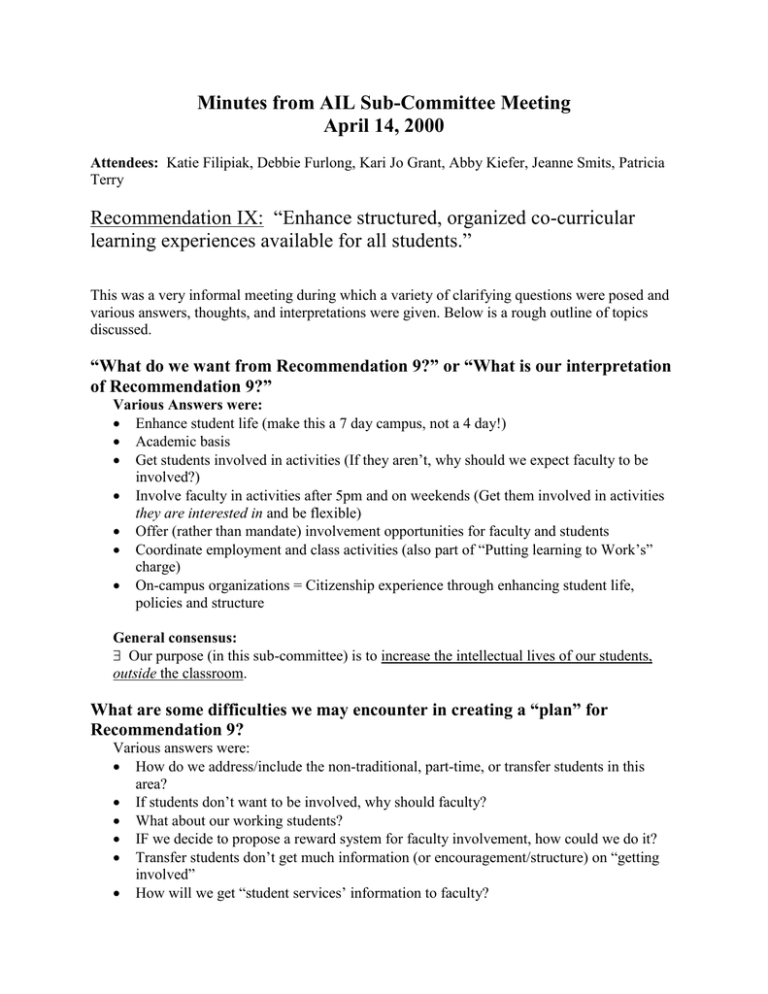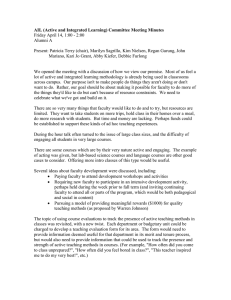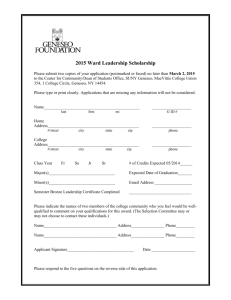4-14-2000( subcommittee on rec #IX )
advertisement

Minutes from AIL Sub-Committee Meeting April 14, 2000 Attendees: Katie Filipiak, Debbie Furlong, Kari Jo Grant, Abby Kiefer, Jeanne Smits, Patricia Terry Recommendation IX: “Enhance structured, organized co-curricular learning experiences available for all students.” This was a very informal meeting during which a variety of clarifying questions were posed and various answers, thoughts, and interpretations were given. Below is a rough outline of topics discussed. “What do we want from Recommendation 9?” or “What is our interpretation of Recommendation 9?” Various Answers were: Enhance student life (make this a 7 day campus, not a 4 day!) Academic basis Get students involved in activities (If they aren’t, why should we expect faculty to be involved?) Involve faculty in activities after 5pm and on weekends (Get them involved in activities they are interested in and be flexible) Offer (rather than mandate) involvement opportunities for faculty and students Coordinate employment and class activities (also part of “Putting learning to Work’s” charge) On-campus organizations = Citizenship experience through enhancing student life, policies and structure General consensus: Our purpose (in this sub-committee) is to increase the intellectual lives of our students, outside the classroom. What are some difficulties we may encounter in creating a “plan” for Recommendation 9? Various answers were: How do we address/include the non-traditional, part-time, or transfer students in this area? If students don’t want to be involved, why should faculty? What about our working students? IF we decide to propose a reward system for faculty involvement, how could we do it? Transfer students don’t get much information (or encouragement/structure) on “getting involved” How will we get “student services’ information to faculty? What are some ideas we have brainstormed about to make Recommendation 9 “happen”? Various answers were: Link classes (each new student to Green Bay takes a certain “block” of classes which are shared by 20-30 other students) Do the above, but by major Housing Themes (in existence) Structured Housing Study Groups Staff participation in existing student organizations Teach classes in the residence halls/housing area Give faculty release time for active involvement in student organizations Let all students know (as freshmen/new students) what benefits they’ll get for involvement Informal study/tutoring/mentoring Increase space to relax, (for faculty and students together) throughout the academic campus buildings (open lounging areas with comfortable furniture, tables and chairs, etc.) Faculty dinners at their homes (have a fund which faculty can request limited funds to reimburse expenses) Reading clubs, lead either by faculty or students Weekly brown-bag lunches for non-trads and transfers Day-care facilities for young children of our college students (may touch upon “Putting learning to work” for students to work there) How would we integrate transfer students into our current student population? Various answers were: Student mentoring One-on-one interactions with a consistent person, either through weekly emails or in person Somehow facilitate the relationship between the student and the institution What are some ways that faculty could get involved in co-curricular activities? Various answers were: Promote campus events and activities within their classes (i.e., make an effort to be an knowledgeable source of events available to students) Coordinate programs, speakers, lectures, etc. with other groups on campus (i.e., other academic or student services departments) Advise a student organization Attend events of personal interest How would we define “co-curricular experiences” as being different from “extra-curricular” experiences (if at all)? Various answers were: Examples of “extra-curricular” activities were: University Bowling Team, any religiously-affiliated student groups (this is not engaged citizenship, it is personal choice) Examples/definitions of “co-curricular” activities were: Involves intellectual development Connection between typical “academic” and “student life” areas of the campus Structured development of leadership skills outside of the classroom (e.g., speaking in front of groups, providing service to community members, providing educational lectures, discussions, programs, etc. for others) Group- or team-oriented activities done with a purpose A student organization which has a purpose and meets regularly (minimum of 2 hours/month) and plans events according to their mission or goals Meeting was adjourned at 1pm and the group agreed to meet again for more concrete discussion. Date, time and location to be determined at next AIL meeting (4/29/00 at 8am in CL 710) Minutes submitted by: Kari Jo Grant

